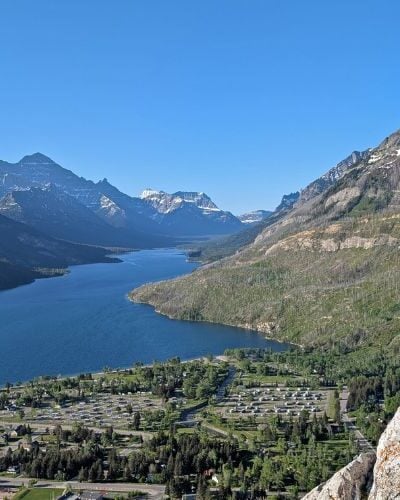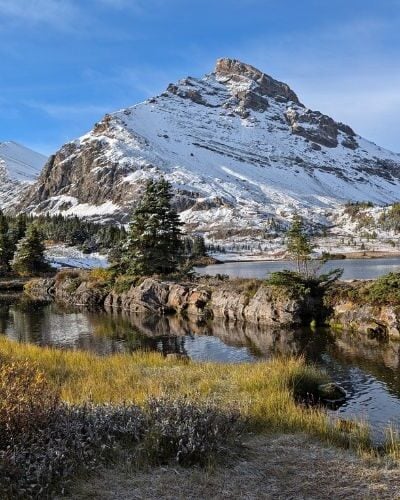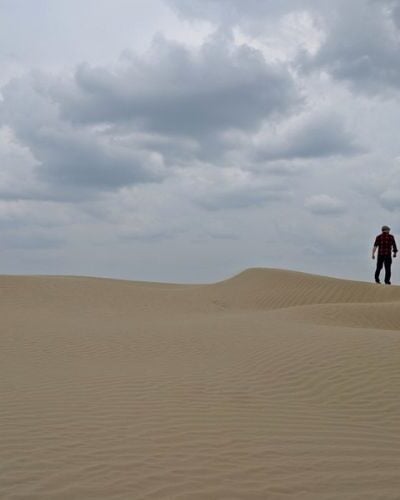Did you know that you can see grizzly bears in BC’s legendary Great Bear Rainforest right from Vancouver Island? And from the colourful historic village of Telegraph Cove, too – combining wildlife and heritage in one adventure!
Better still, you can join Telegraph Cove grizzly bear tours any time between May and September. There’s the chance to see other animals too, such as black bears, humpback whales, porpoises and potentially even orcas.
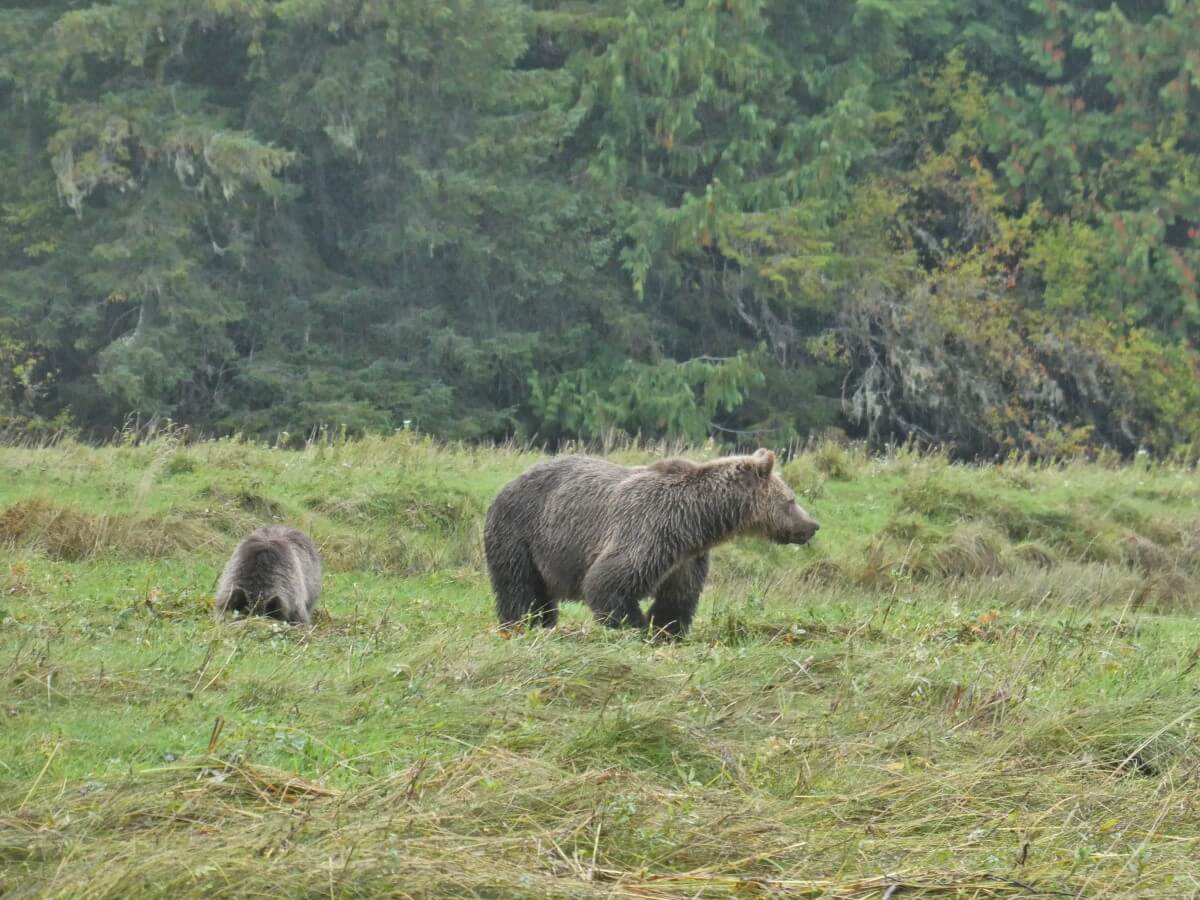
JR and I have encountered many wild bears over the years in BC, but out of respect and safety concerns, our sightings have always been very brief and from a far distance.
Being able to observe grizzly bears for an extended period with minimal disturbance, ensuring they can still go about their daily activities, is a truly special experience and one I will never forget.
This post will share all the details about grizzly bear watching from Telegraph Cove on Vancouver Island, including what to expect, the best time to go, what to bring and where to stay, all based on our recent first hand experience.
I’ll also talk about Tide Rip Grizzly Adventures’ respectful approach to wildlife viewing, ensuring every encounter is safe, sustainable, and fair to the bears.
In partnership with Vancouver Island North and Destination BC. There may be affiliate links below. If you click and make a purchase, we may receive a percentage of the sale.
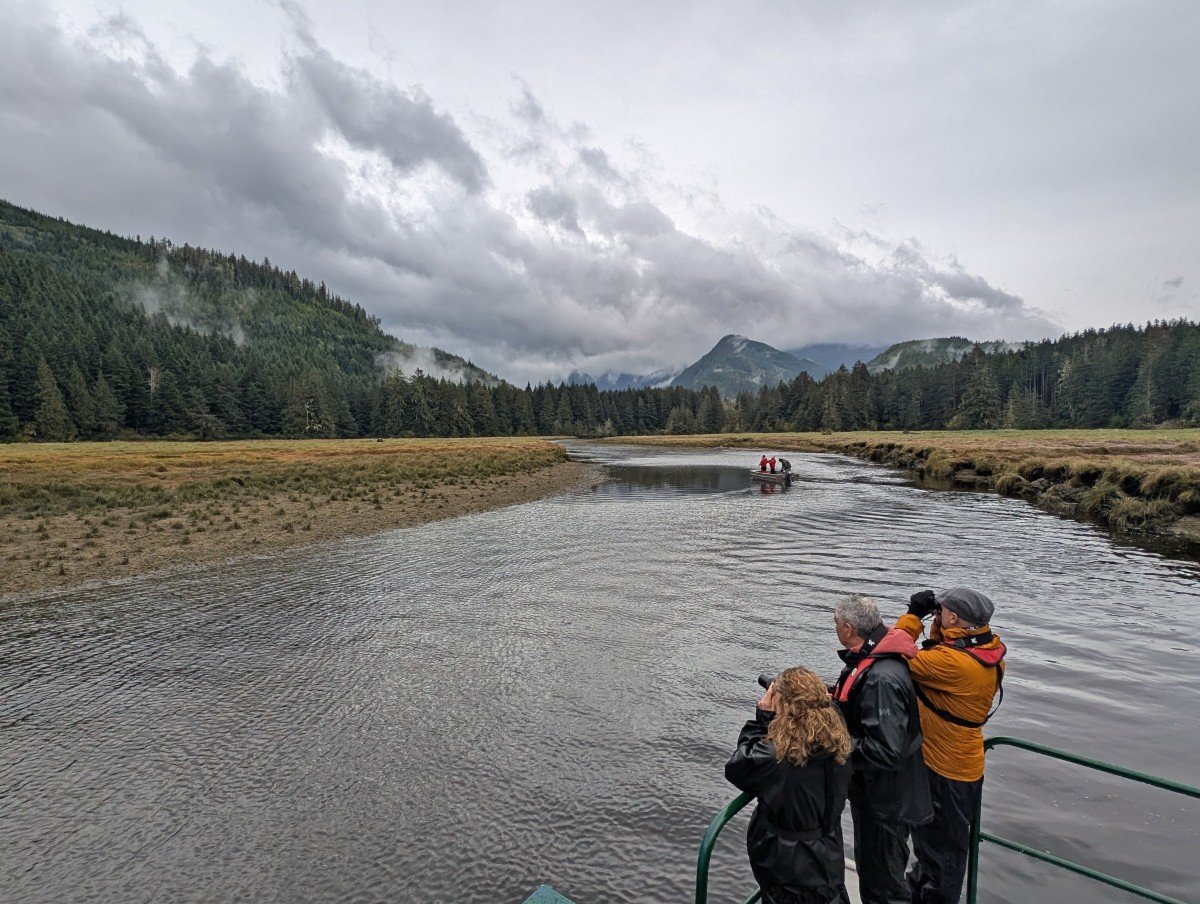
Telegraph Cove, Knight Inlet and the Great Bear Rainforest
Located on northern Vancouver Island, Telegraph Cove is a former sawmilling and cannery village with a year round population of only 20 residents.
Featuring brightly painted heritage buildings on stilts and a wooden boardwalk, it transforms into a buzzing eco-tourist resort from May to September. It is situated on the traditional territory of the Kwakwaka’wakw people.
The adjacent Johnstone Strait is teeming with marine life, with the largest resident pod of orcas in the world alongside humpbacks, porpoises, seal colonies and more.
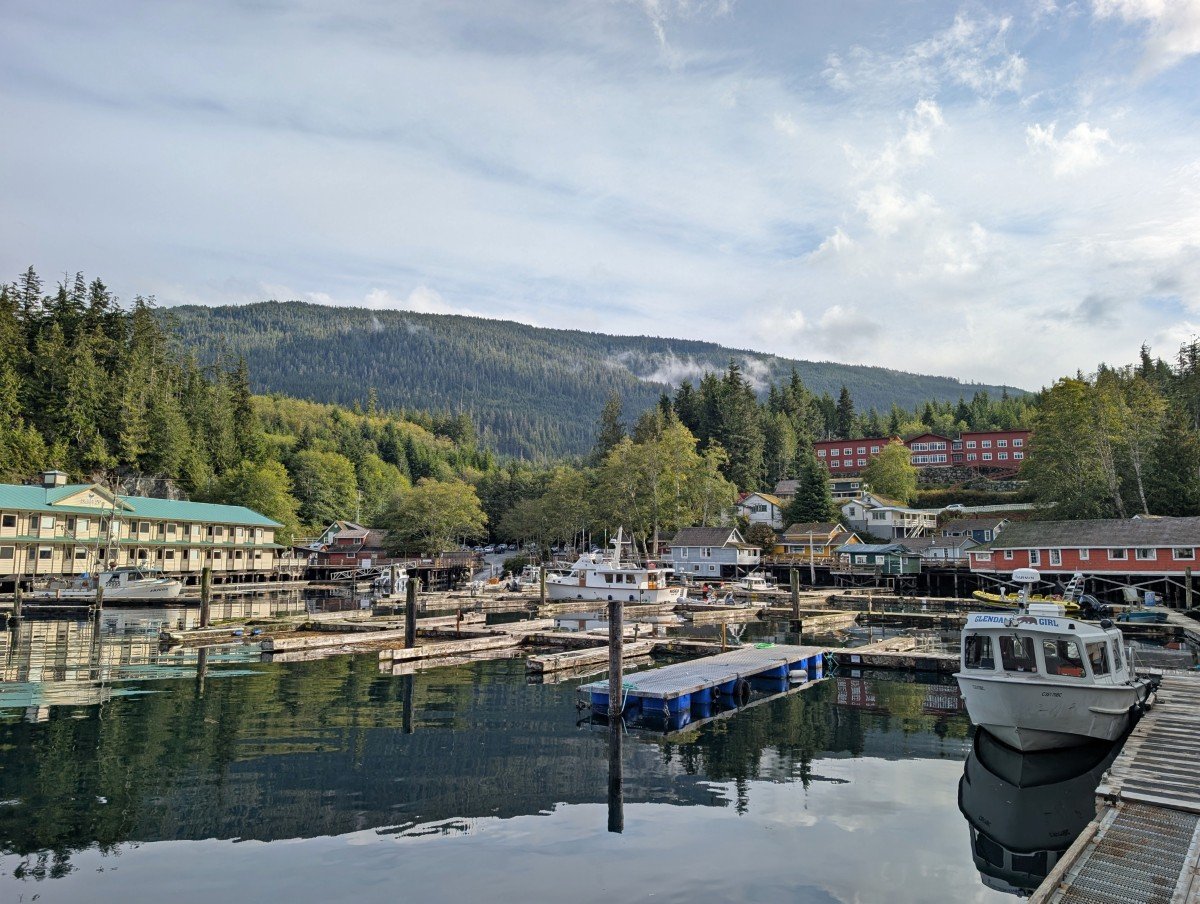
Beyond the Strait, a maze of islands and channels opens into Knight Inlet, a fjord that stretches for some 125 kilometres (the longest in British Columbia!)
Knight Inlet is part of the Great Bear Rainforest, a protected area covering 6.4 million hectares on BC’s north and central coast. The temperate rainforest here is home to ancient Western Red Cedar trees, 26 different First Nations and an incredible diversity of wildlife.
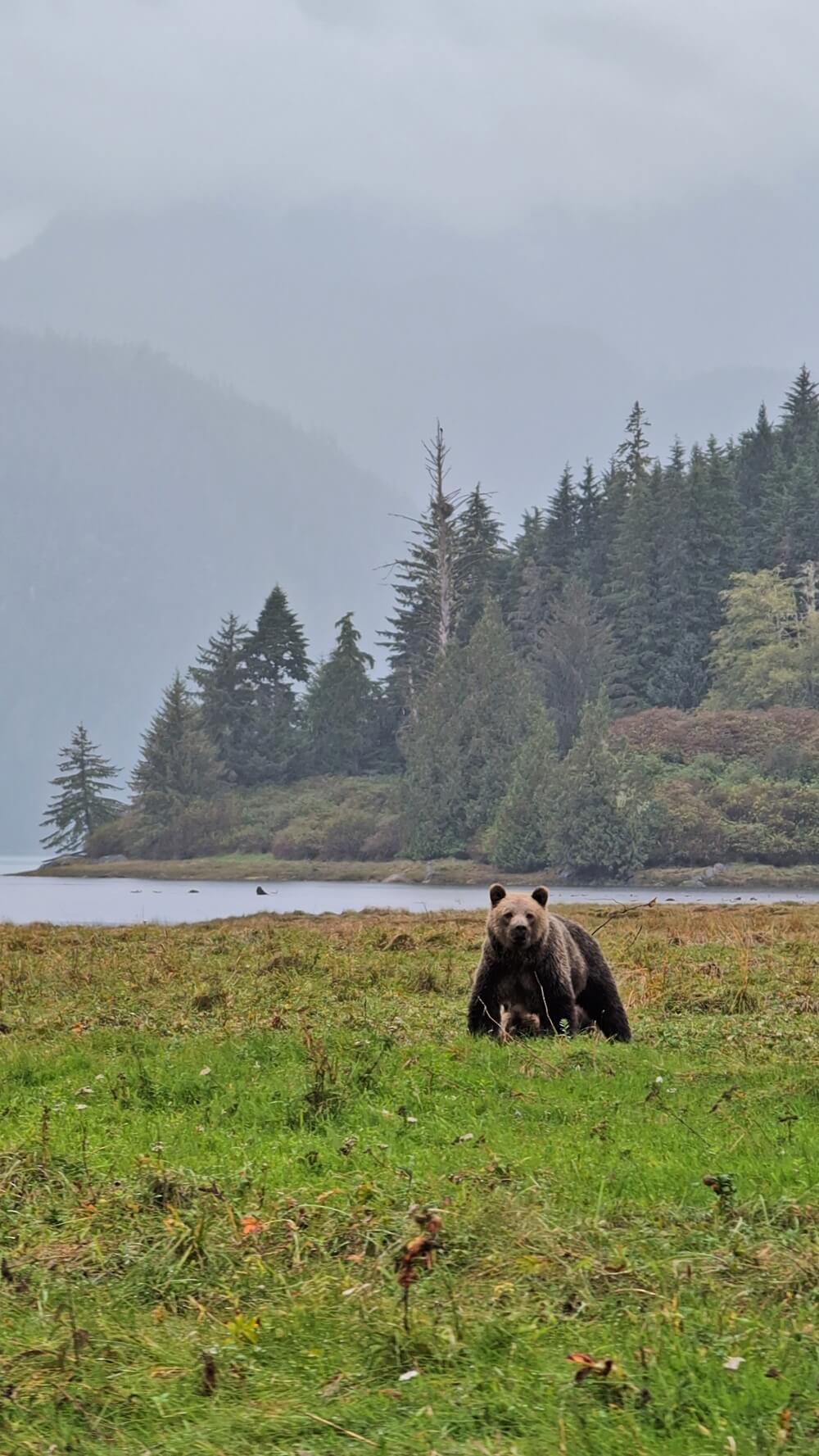
Grizzly bears and black bears both roam the Great Bear Rainforest, as well as the legendary Kermode Bear. The rare, almost white Kermode Bear is considered to be a genetic variation of the black bear and only exists in the Great Bear Rainforest.
With all this in mind, Telegraph Cove is the perfect departure point for wildlife watching tours. This post will focus on grizzly bear watching tours specifically. There are many places to go whale watching on Vancouver Island but only a few tours offer the chance to see grizzlies.
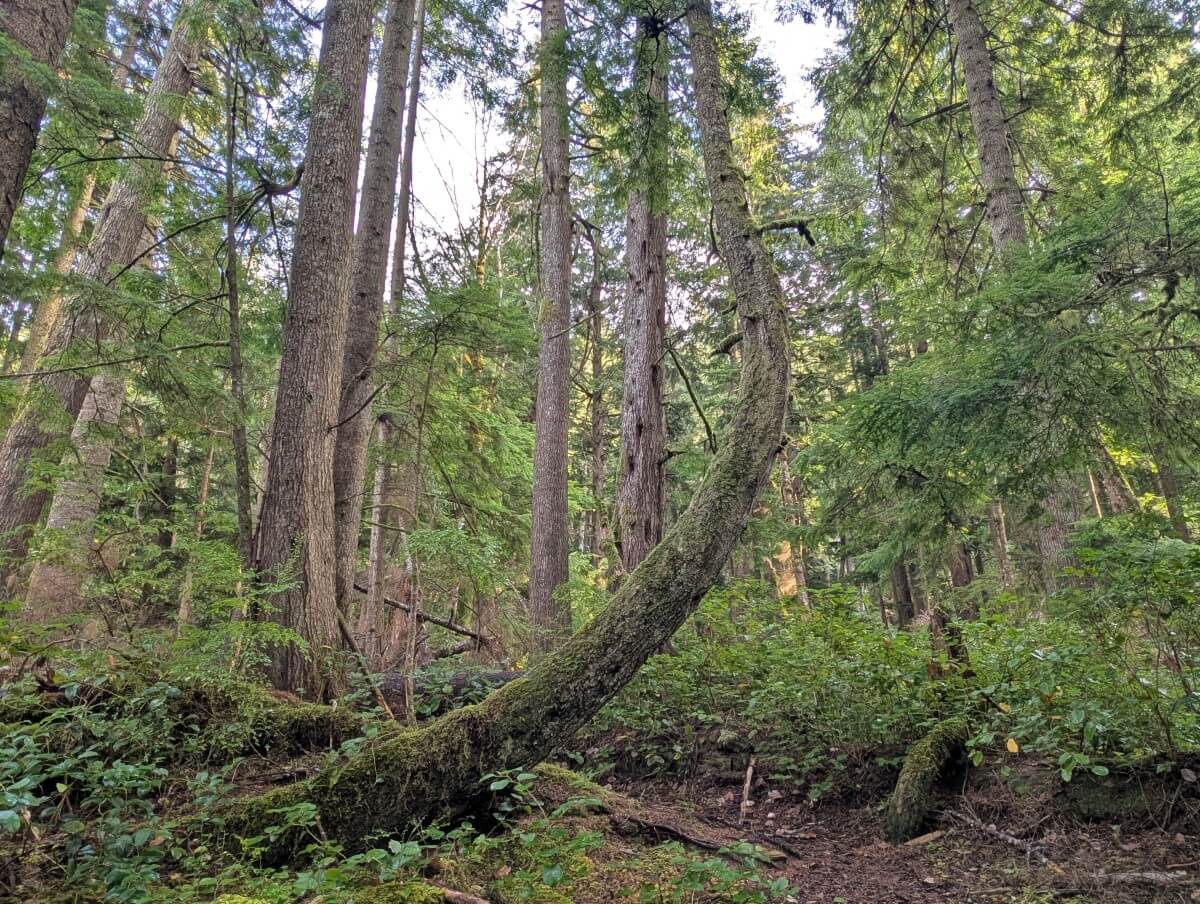
Grizzly bear watching from Telegraph Cove with Tide Rip Grizzly Adventures
Tide Rip Grizzly Adventures operate full day small group boat tours from Telegraph Cove to Glendale Cove in Knight Inlet. The season starts in mid May, as the grizzlies emerge from winter in their high elevation dens and return to the coast in search of food.
Their number one target is the protein-rich sedge grasses, which makes up about 70% of their diet in this spring period. The intertidal zone provides variation, with crabs, small fish, clams and barnacles.
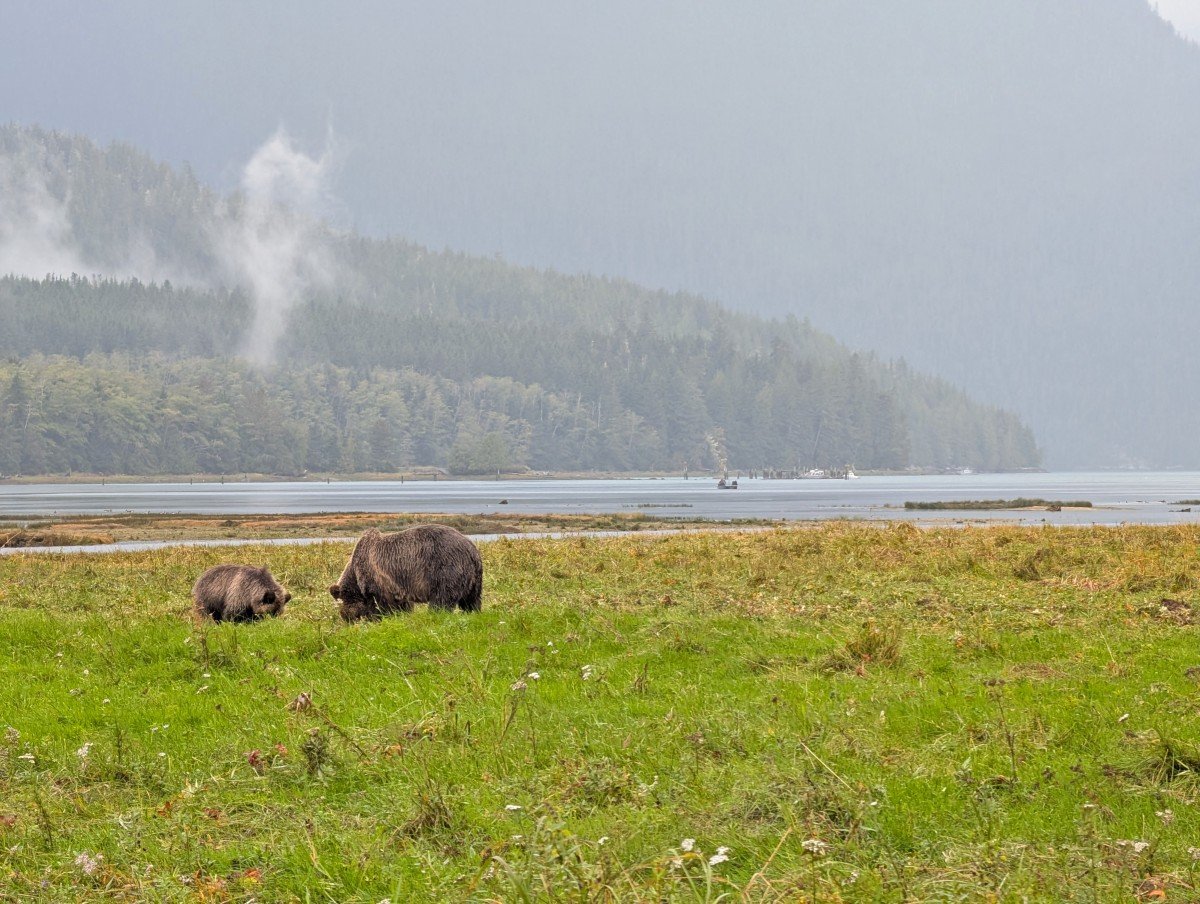
Depending on the status of the unpredictable local salmon run, the grizzlies may supplement their diet with this nutrient-dense fish in August and September. Tide Rip’s last day of tour operations is 30th September.
Grizzly tours with Tide Rip are usually 8.5 hours long and start early from the Telegraph Cove marina. The journey to Glendale Cove in Knight Inlet takes around 2 hours one way.
Tide Rip claim to have a 95% success rate for seeing grizzly bears. This is undoubtedly at least partly due to the dedication of the tour guides, who know this area inside out.
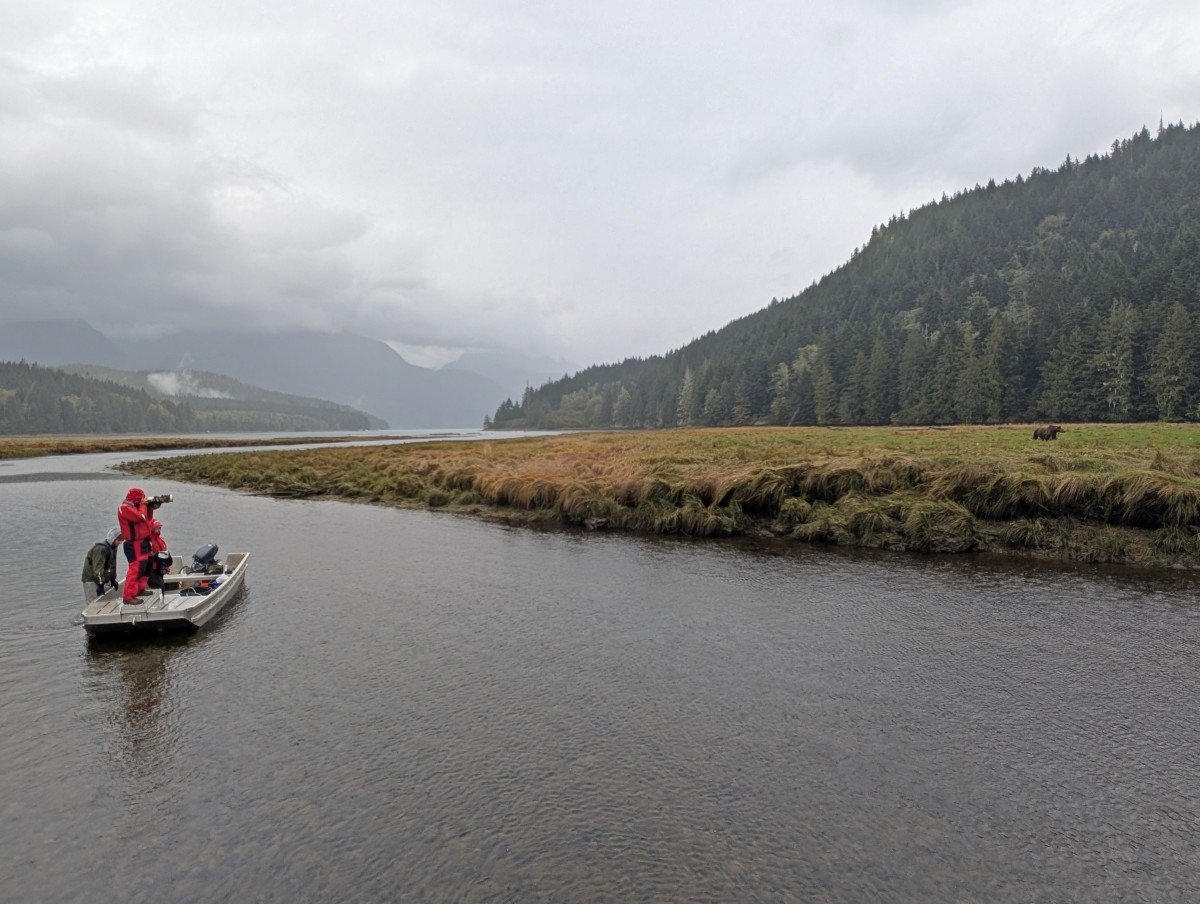
Our tour was led by Matthias and Ishbel, who referred to the grizzlies by name and knew their unique personalities, backstories and favourite hang out spots.
And their knowledge isn’t limited to the grizzlies either – their expertise covers the whole coastal ecosystem. This level of passion truly makes a difference and enhances every moment of a tour like this.
Grizzlies aren’t the only stars of these tours. Black bears are usually easy to spot along the way to Knight Inlet, and you may also have a chance to see humpbacks, seals and sea lions. The luckiest guests may even encounter orca whales.
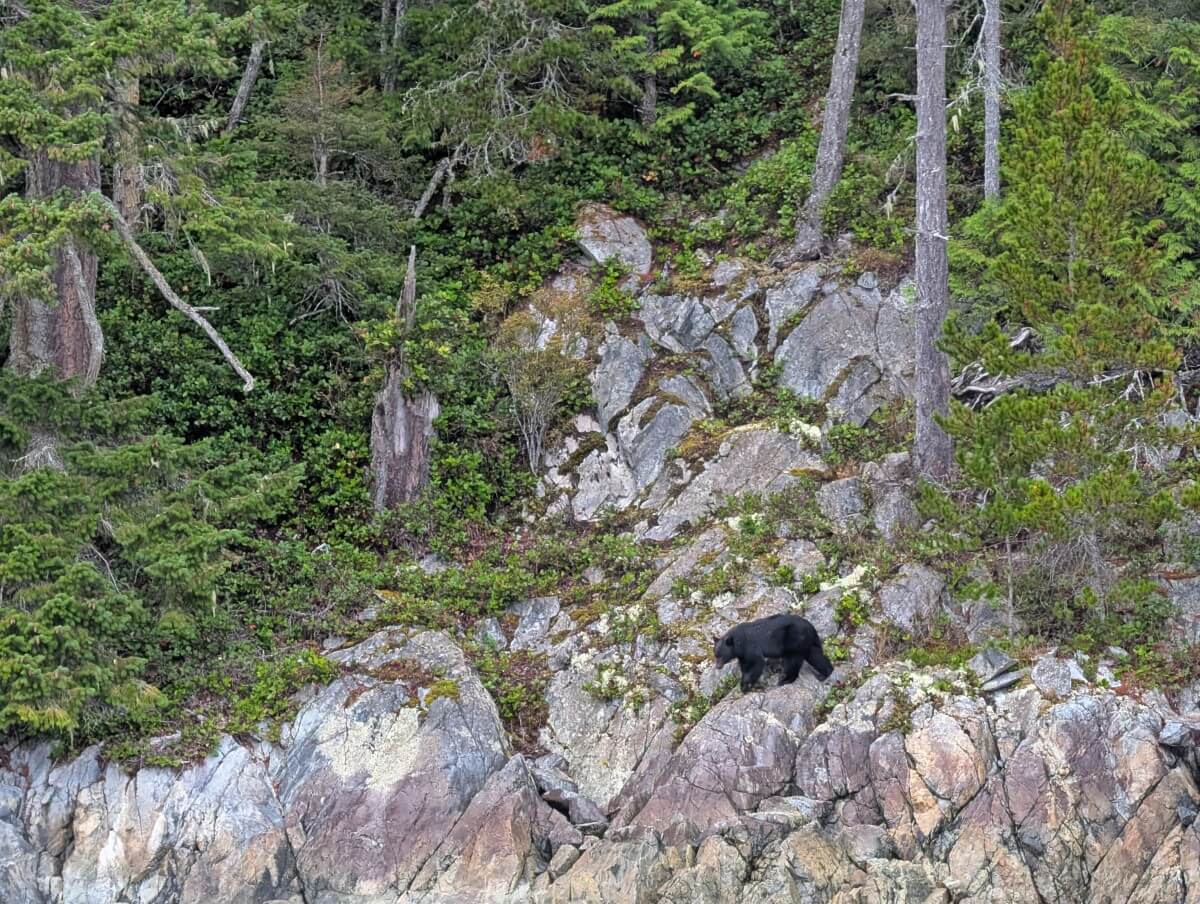
Tide Rip grizzly tour experience
Starting a tour in the dark is always exciting. After checking in the day before, we arrived at the Telegraph Cove General Store just before 7am, where a light breakfast and coffee were served during the safety briefing.
Afterwards, our group of twelve (ten guests and two guides) walked down to the marina to board the Grizzly Girl. It’s about a two-hour journey to Glendale Cove in Knight Inlet…assuming you don’t stop. And on a tour like this, you really want to have many reasons to stop. And we did!
Only a few minutes from Telegraph Cove, we encountered a minke whale. Next, a delightfully noisy sea lion colony. During quieter parts of the journey, Matthias shared facts about bear biology, the coastal ecosystem and the specific bears that call this area home.
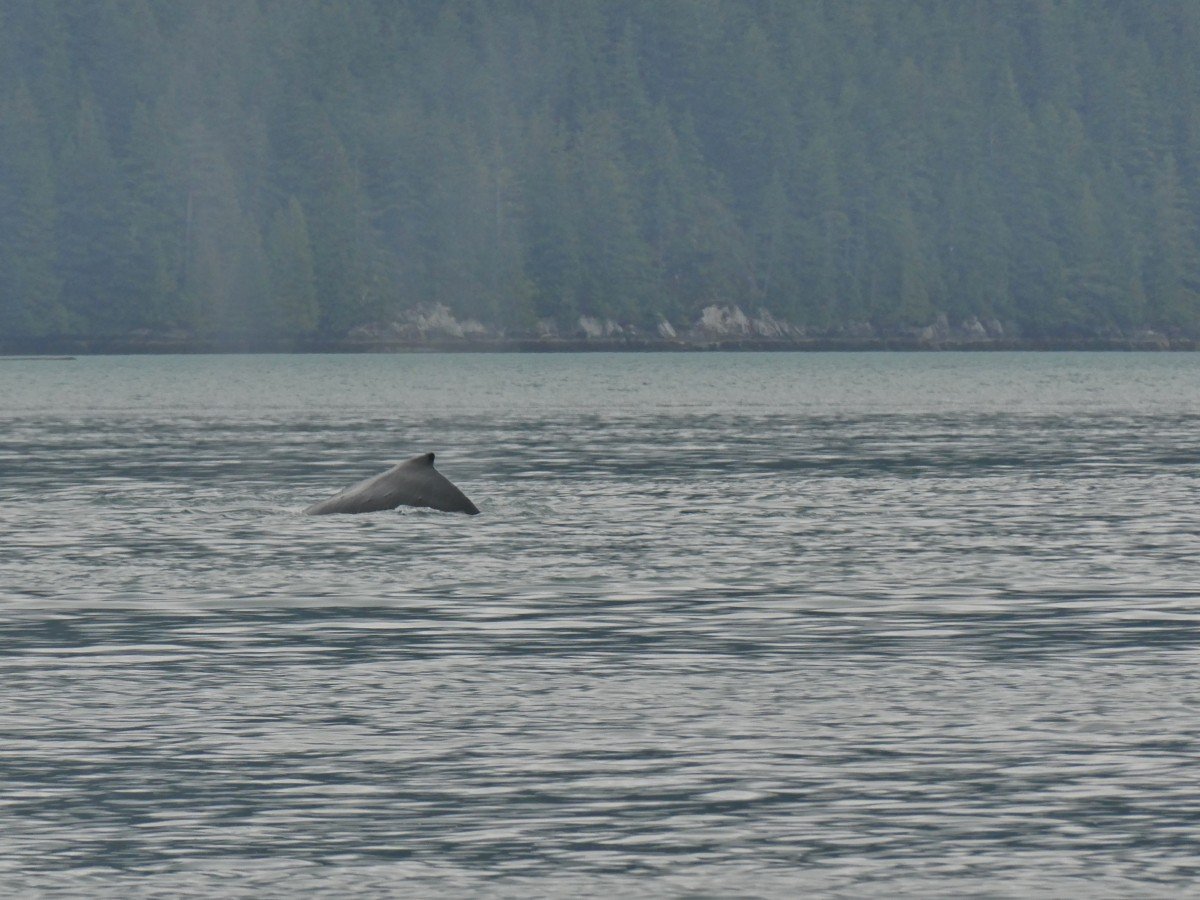
Our first black bear was spotted within the first hour. Even from the boat, we could hear the thud of rocks being lifted and tossed, followed by the crunch of crabs and barnacles as the bear foraged along the shore. This was the first of seven black bears we saw that day.
Further into Knight Inlet, the forested mountains surrounding us began to get progressively steeper and the ocean more turquoise. And then, success. An ‘elder’ grizzly bear on the beach. It was magical to watch a grizzly so focused on its own world, entirely unbothered by us.
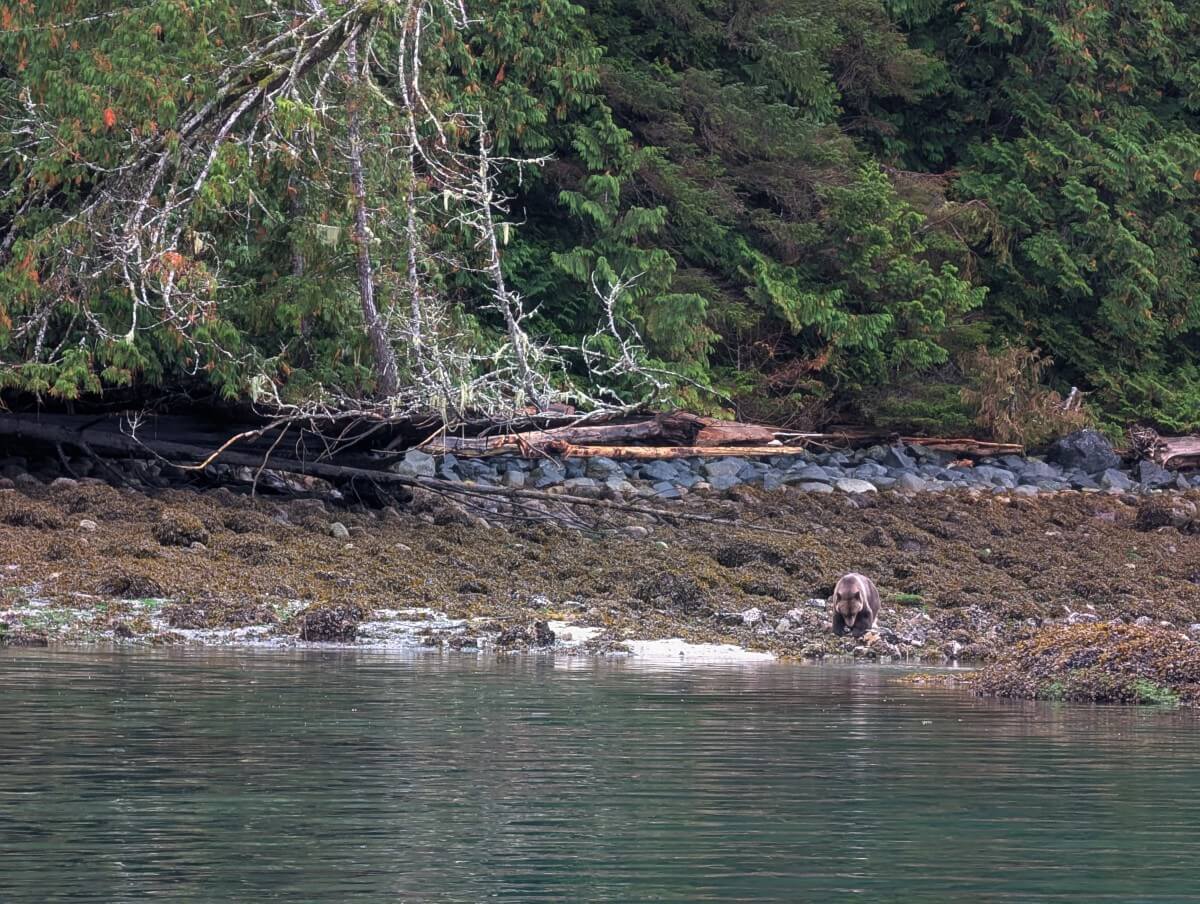
Glendale Cove
After a respectful amount of time, we moved on to Glendale Cove. Here, we disembarked the Grizzly Girl, enjoyed lunch beneath covered shelters and then boarded a skiff viewing boat.
This small, uncovered vessel has a shallow draft, which means the guides are able to physically pull it into low lying areas of the river.
This feature came in handy for our next encounter. Lenore, one of the two Glendale Cove matriarchs, was grazing on sedge grass with her cub. Thanks to the skiff and its elevated viewing platform, we were able to get a great view of both bears.
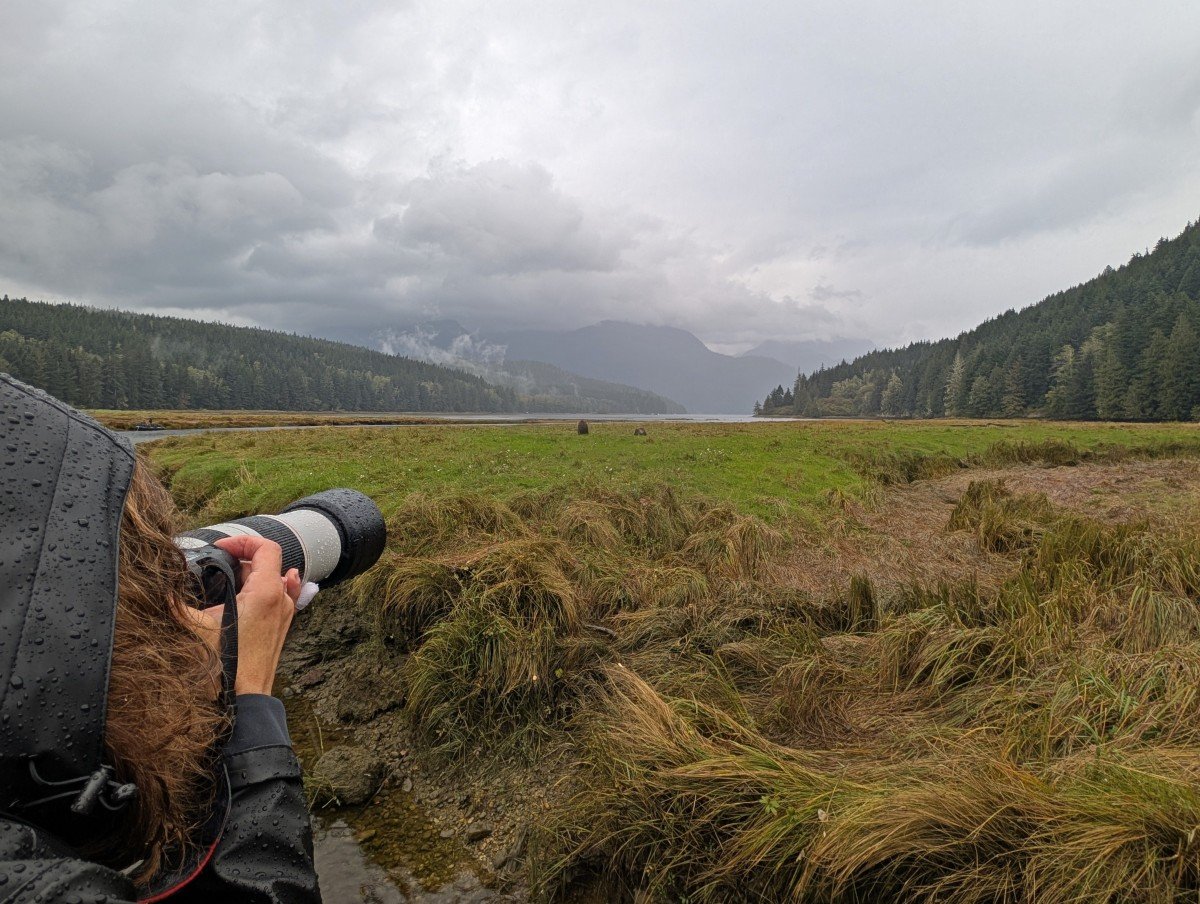
It was a privilege to watch these powerful yet graceful creatures from a safe distance for such an extended time – no fear, no barriers, just quiet observation. The fjord backdrop was just the icing on the cake.
On the way back to Telegraph Cove, we stopped to see some First Nation pictographs on a cliff, and several groups of humpback whales. It was a bumpy ride back across the Strait but we still made it back for 4pm. A perfect (albeit rainy) day filled with amazing wildlife and breathtaking scenery.
If you love the sound of this tour but aren’t keen on boats, an alternative is to take a grizzly bear watching tour from Campbell River. These tours have a land based section with multi-level viewing towers.
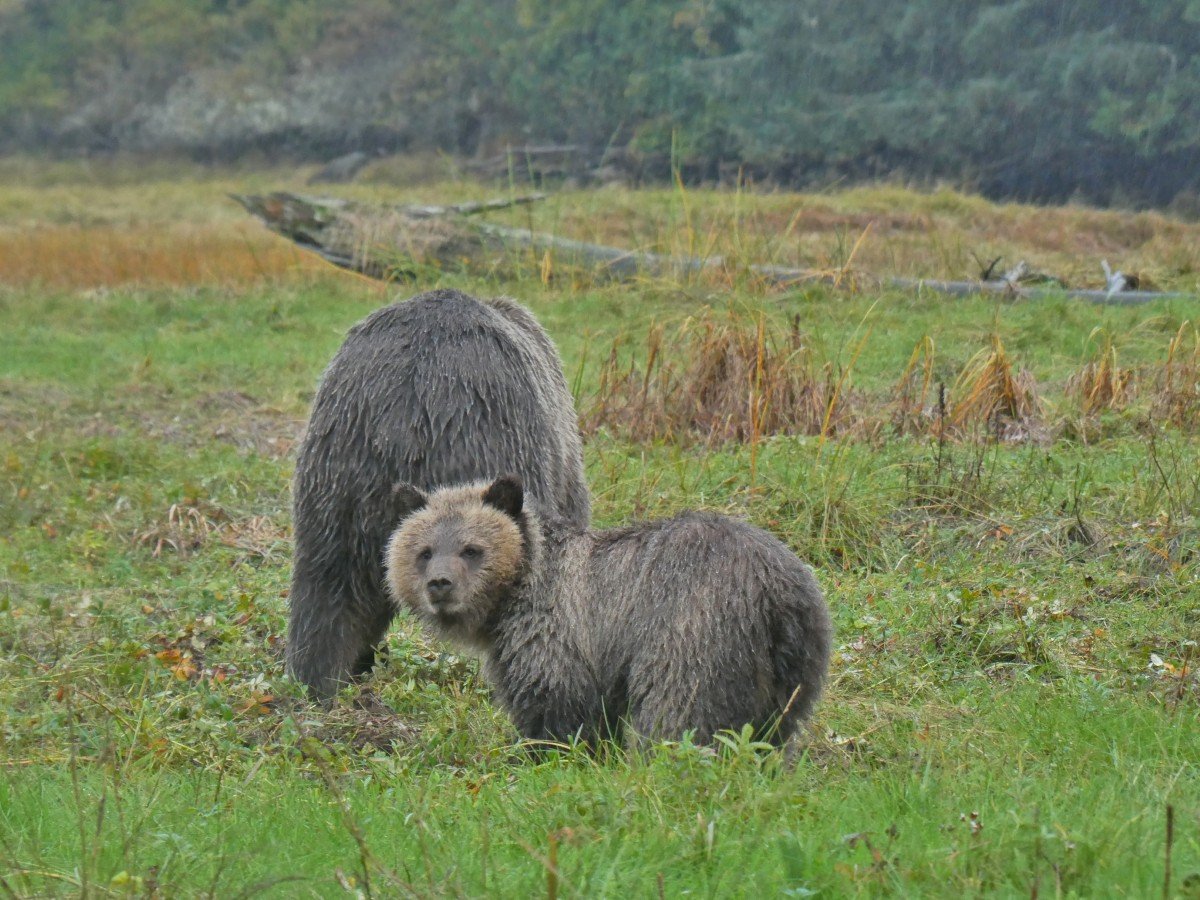
The Commercial Bear Viewing Association
Tide Rip Grizzly Adventures is a member of the Commercial Bear Viewing Association of British Columbia (CBVA). The CBVA is dedicated to protecting wild bears and their ecosystems.
Members must follow Best Management Practices and a Code of Conduct to maintain the highest standards of ethical and sustainable bear viewing for guests and bears alike.
We saw plenty of proof of this on our Tide Rip tour. For one, our guides were deeply committed to keeping the bears safe and undisturbed. In Glendale Cove, our group had a specific time spot to enter the river estuary. This restricts the number of groups in the area.
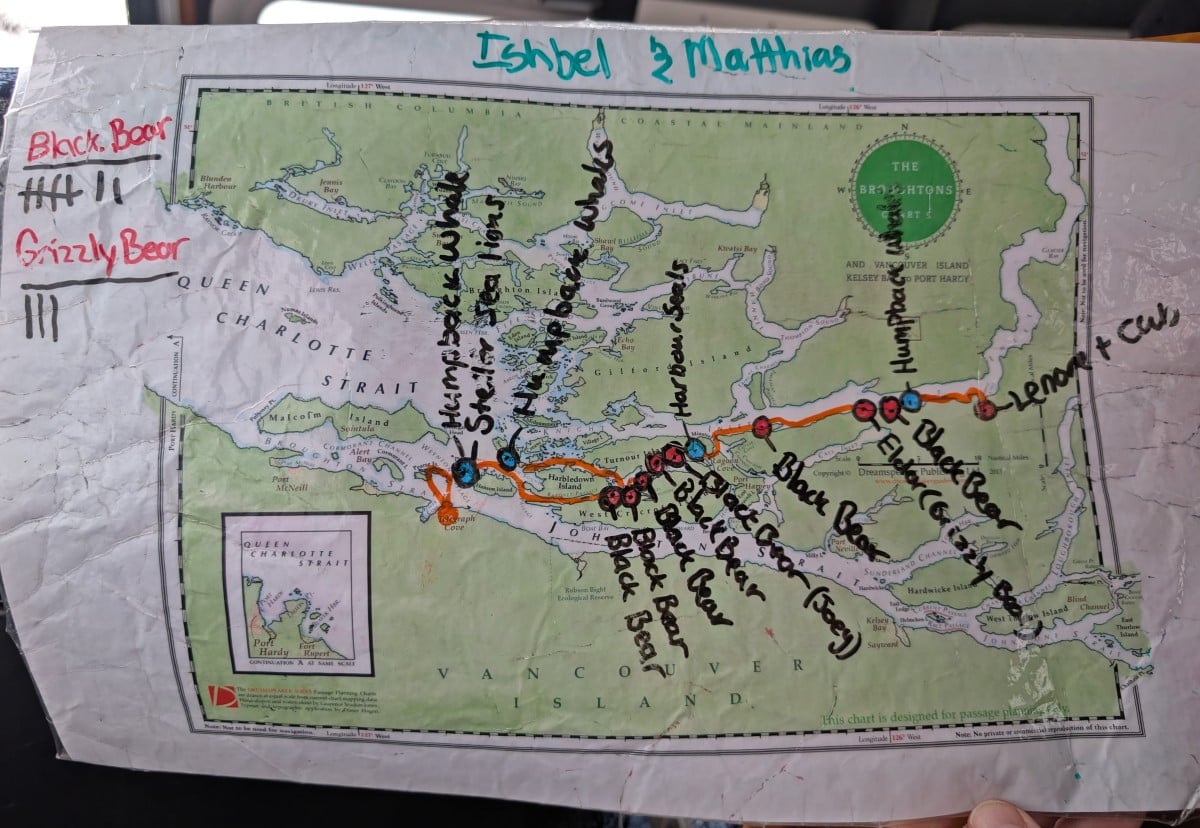
The CBVA operates a guide certification program. The Level 1 program includes bear biology, ecology, behaviour, bear/human encounters, minimising effects, guest education and more. For Level 3 certification, a guide must log more than 350 hours of bear interaction.
When joining a CBVA member bear watching tour, expect the following:
- Knowledgeable guides – Carefully planned boundaries with predictable behaviour
- Minimal disturbance – Guides promote quiet viewing with limited noise and movement
- Respectful viewing from a distance – Ensuring that bears have personal space
- Group safety – Guests stay together and follow guide instructions at all times
- Organised visitation – Careful coordination with other tour groups to avoid overcrowding
- Controlled food and waste – Bears cannot gain access to food and trash
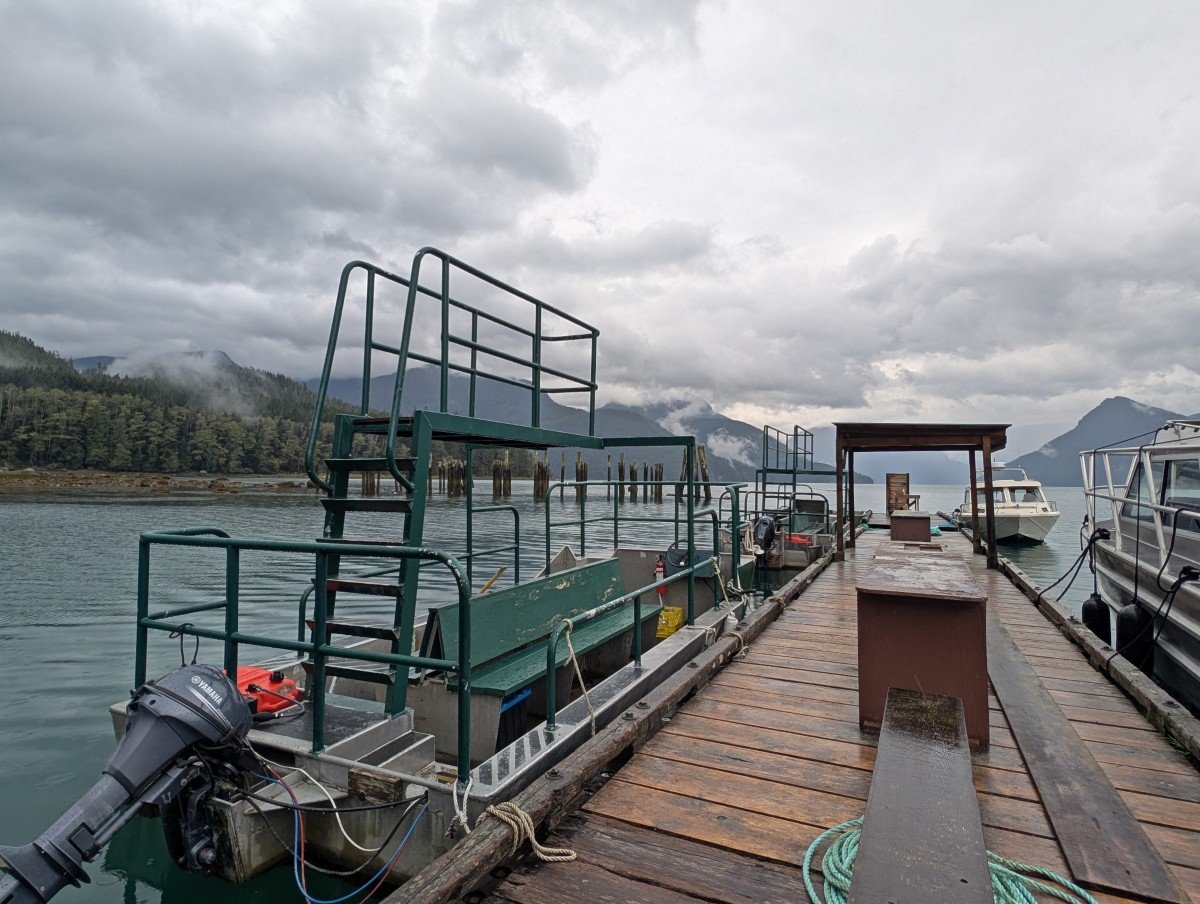
Telegraph Cove grizzly bear watching: trip planning details
Sold on the idea of taking a grizzly bear tour from Telegraph Cove? Here’s everything you need to know about planning a trip.
How to get to Telegraph Cove
The community of Telegraph Cove is located to the north of Vancouver Island, about 4 hours drive from Nanaimo (355km). From Victoria, the trip takes about six hours (465km).
The main part of the journey takes place on Highway 19. Beyond Campbell River, this highway narrows and becomes a lot more winding. It’s more remote too, with only a couple of places to buy gas.
Make sure you have everything you need for this part of the trip, especially as phone signal is very limited. For road conditions, check DriveBC.
Keep your eyes peeled for elk – I’ve spotted large herds near Sayward before. Drive during daylight hours if you can.
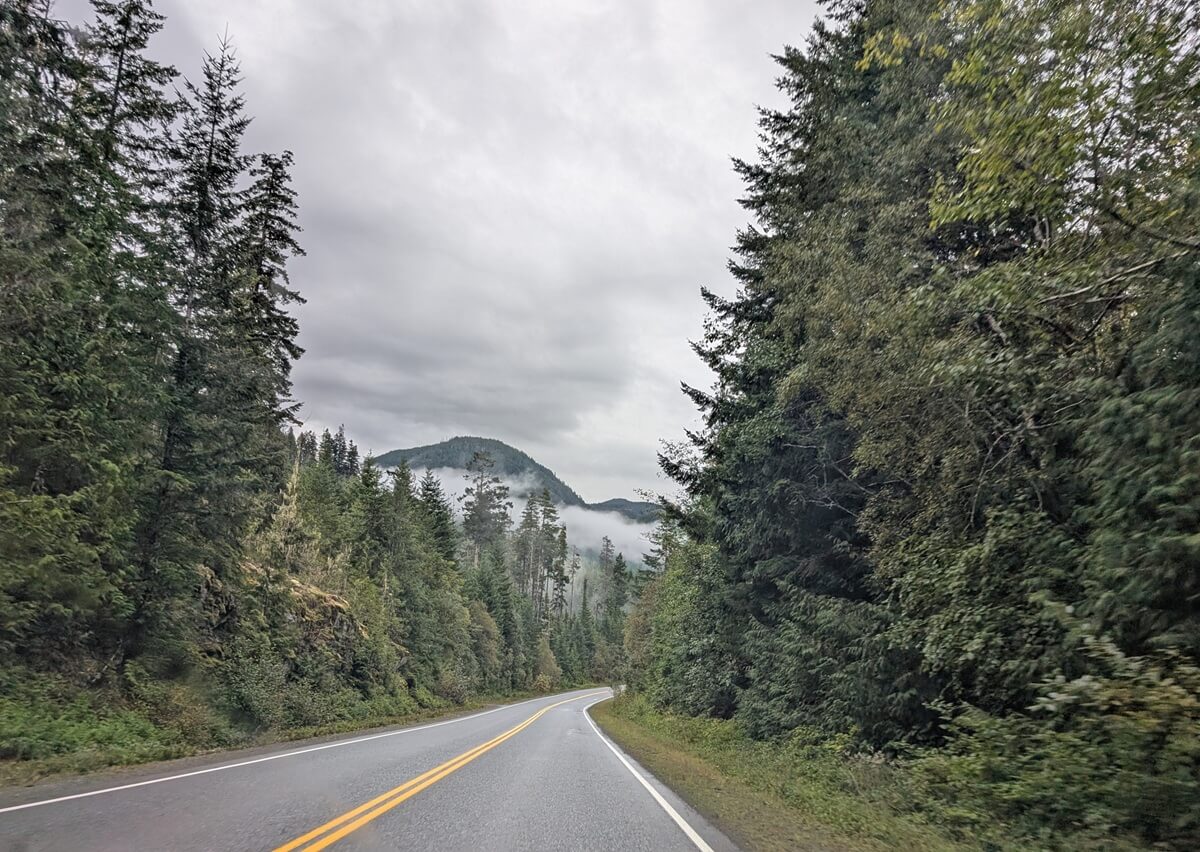
Though there is a bus that goes to nearby Port McNeill, there is no public transportation to Telegraph Cove itself. A car is therefore essential. During the summer months, Tide Rip may be able to pick up guests from Alert Bay or Malcolm Island (near Port McNeill).
The Tide Rip tour office is located in the heart of Telegraph Cove, in the same building as the Telegraph Cove Resort check-in.
Telegraph Cove itself is small, with just a General Store offering basic supplies and souvenirs. Bring everything you need with you. Otherwise, plan to drive into Port McNeill (about 20 minutes away).
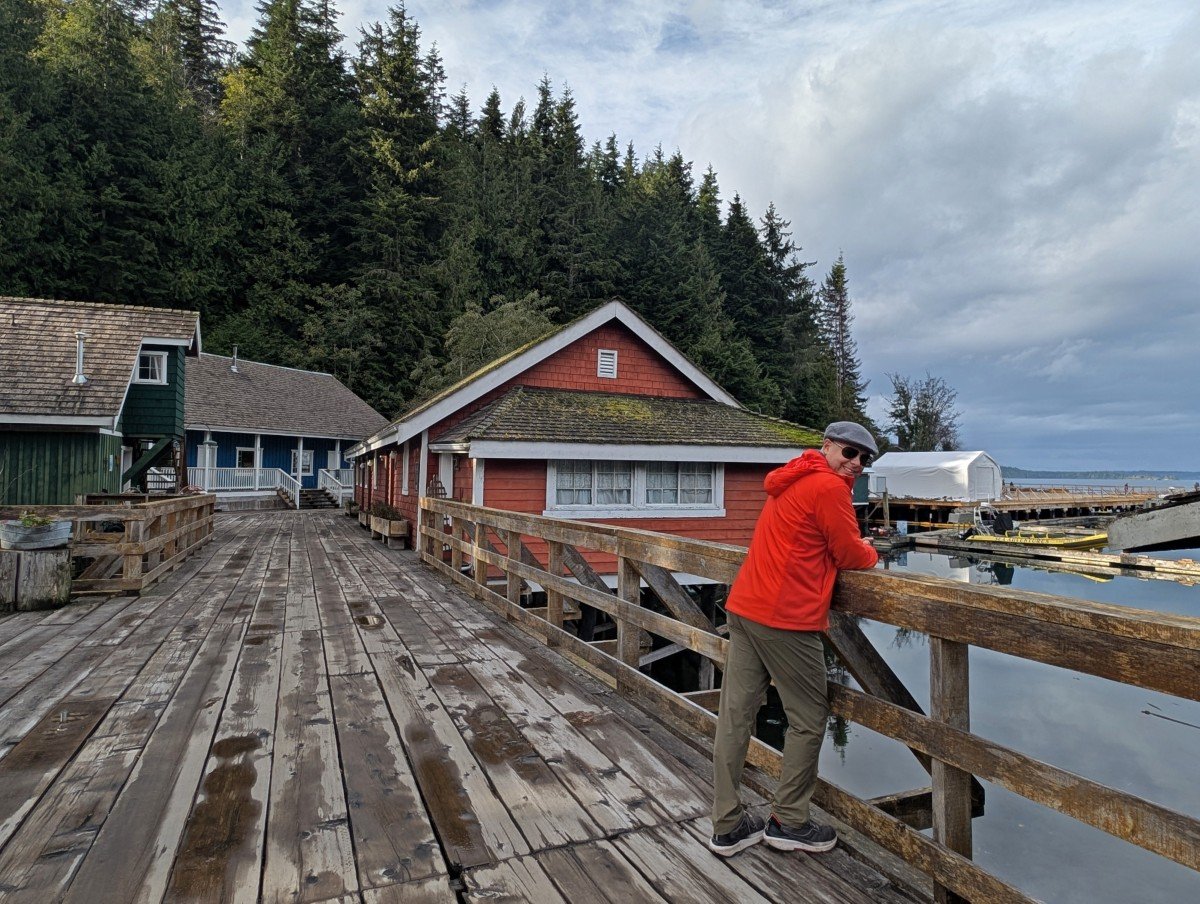
When to go
The huge advantage of grizzly bear watching from Telegraph Cove is that Tide Rip operates tours from mid May to the end of September. It’s a long season, covering the busiest travel time (July, August) as well as some shoulder months too.
According to our guides, each month offers something a little special – there is no ‘wrong’ time to join a tour. The Knight Inlet grizzlies aren’t tied to the fall salmon run the way that the grizzlies in Bute or Toba inlets are.
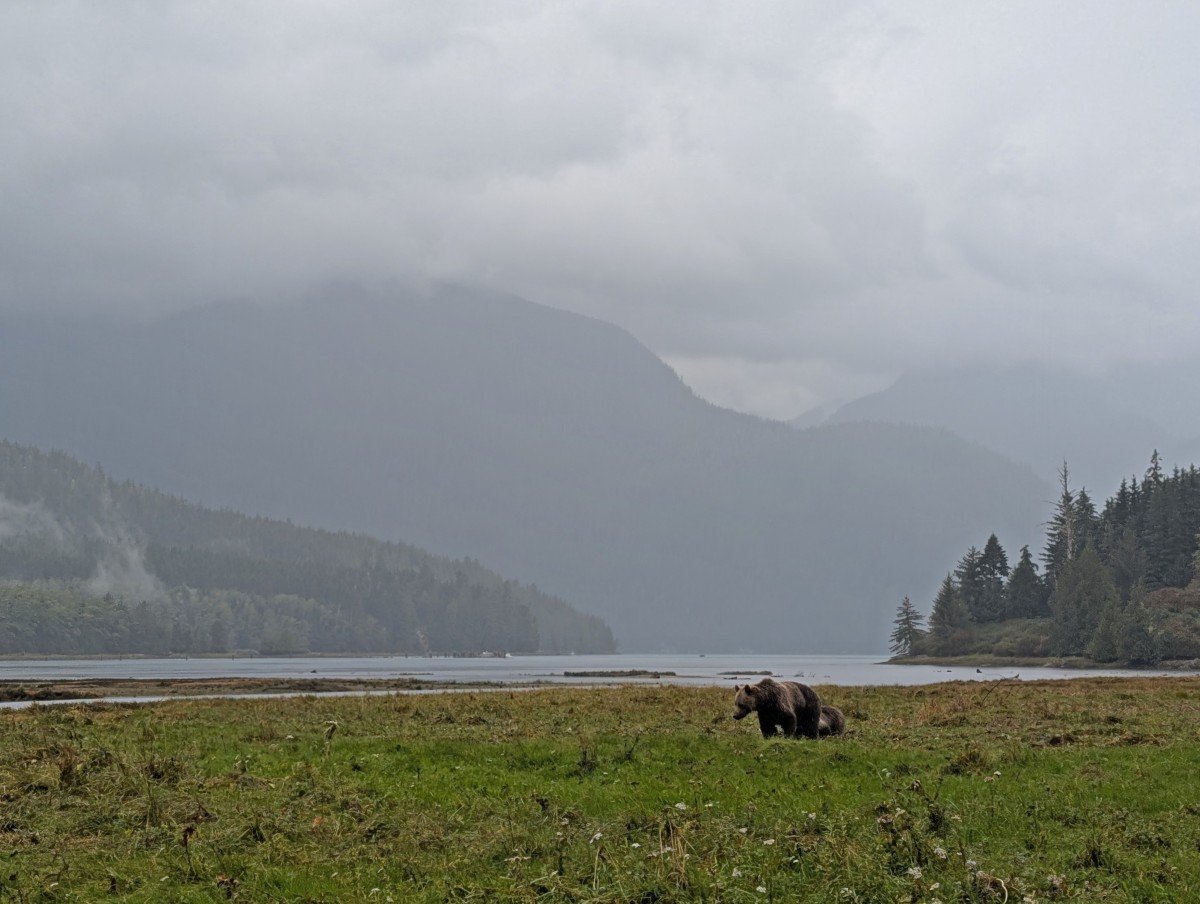
The most consistently successful months for grizzly bear observation, however, are May, June and September. In spring, the bears are attempting to feed while also conserving as much energy as possible. Fast forward to fall and they are trying to fatten up as much as possible for the winter ahead.
Breeding season is in May and June, which means the chances of seeing male grizzlies increases and with it, the chance of seeing mating behaviour.
During hot summer periods, the bears sometimes prefer to stay at higher elevations.
The beauty of this tour is that there is always something to see – black bears, humpbacks, seals, porpoises, sea lions, sometimes even orcas. The local wildlife have their own schedules which means every trip brings its own surprises.
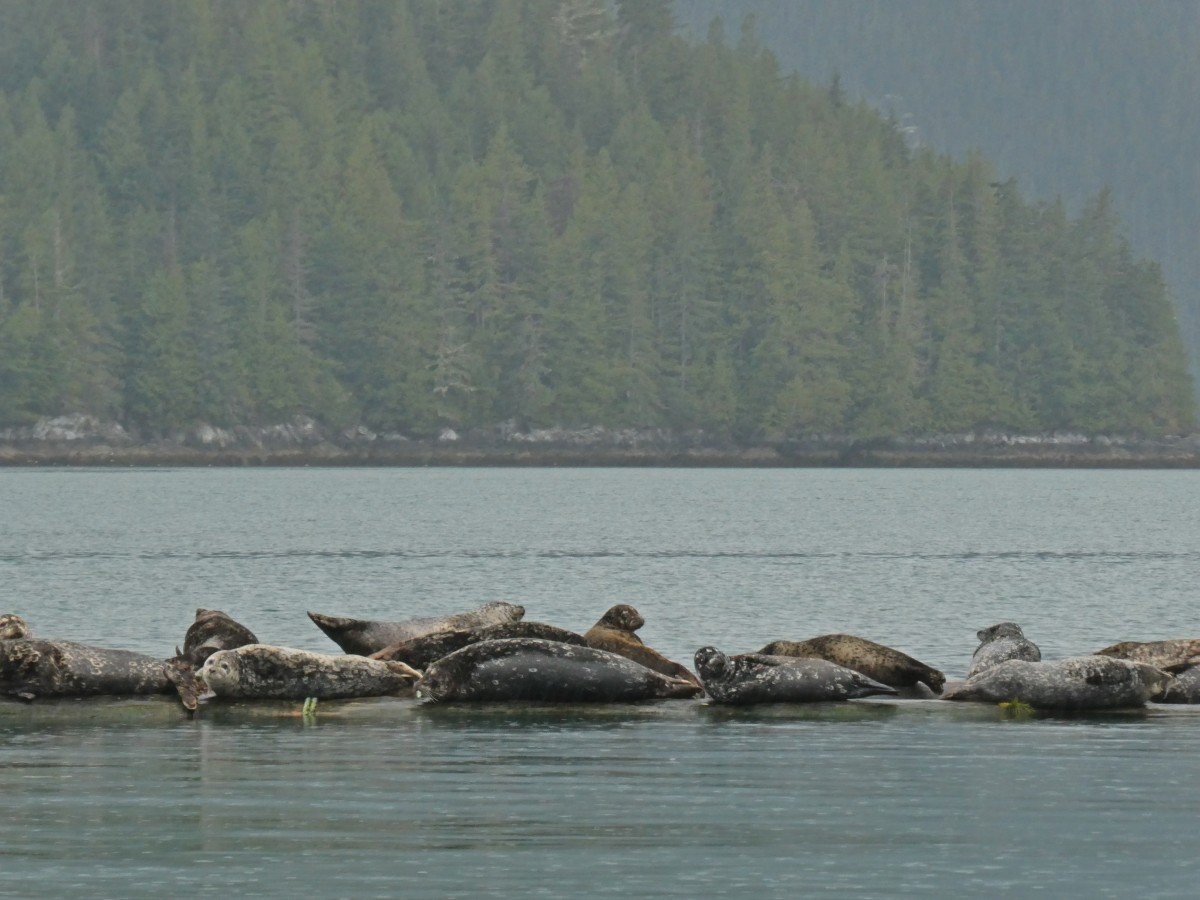
What to wear and bring
This is a full day tour on the ocean so come prepared for changing weather conditions, especially in the spring and fall.
Tide Rip Tours offer guests waterproof jackets and pants, which can be picked up on the morning of the tour.
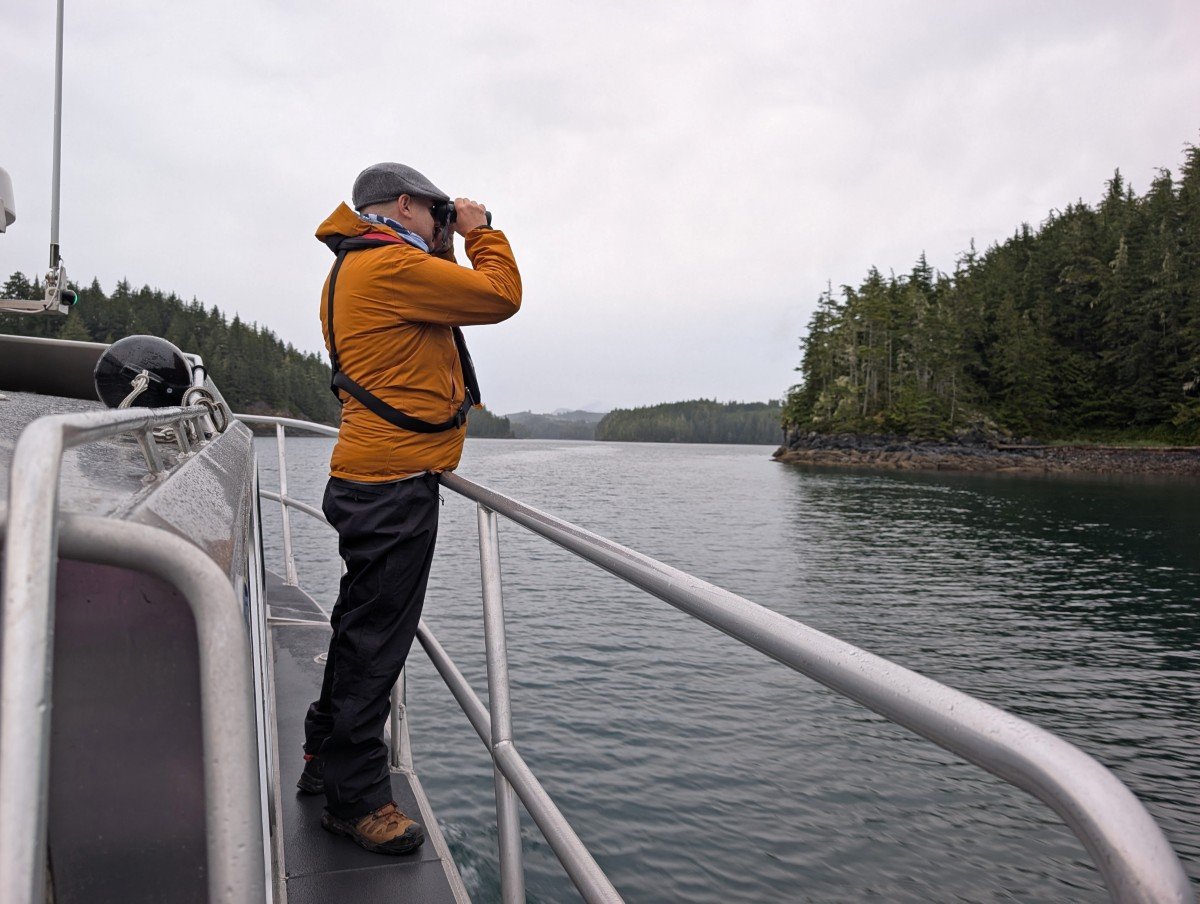
A light breakfast (ours included yogurt, fruit, pastries) and lunch (wraps, chips, fruit and cookies) are provided. Guests with dietary requirements should inform Tide Rip when booking.
Over half of the tour takes place on an enclosed boat, which features comfortable seating and a marine toilet. Expect to spend around two hours on an open-air viewing skiff (no toilet).
I’d suggest bringing the following on the tour –
- Closed-toe shoes. With so many possible weather conditions, closed-toe shoes are best for this tour (hiking shoes, running shoes, boots)
- Sunscreen, sunhat and sunglasses. This is particularly important for the Knight Inlet section of the tour, since the viewing skiff is not covered
- Layers. It is cooler on the ocean, even in the summer months. Bring plenty of different layers, including a warm, long-sleeved top and waterproof jacket (or borrow one).
- Waterproof pants. If rain is possible, pack a pair of waterproof pants too (or again, borrow them). Seating on the skiff will be wet
- Buff/warm hat/gloves. You may be grateful for these warm accessories on windy or wet days
- Water and snacks. Refreshments are available at lunch but it’s a long tour
- Hot drink flask. We wished we had brought a flask (like this one) filled with hot tea or coffee on our rainy late September trip
- Binoculars. If you have your own binoculars, bring them. We borrowed some from Tide Rip Tours
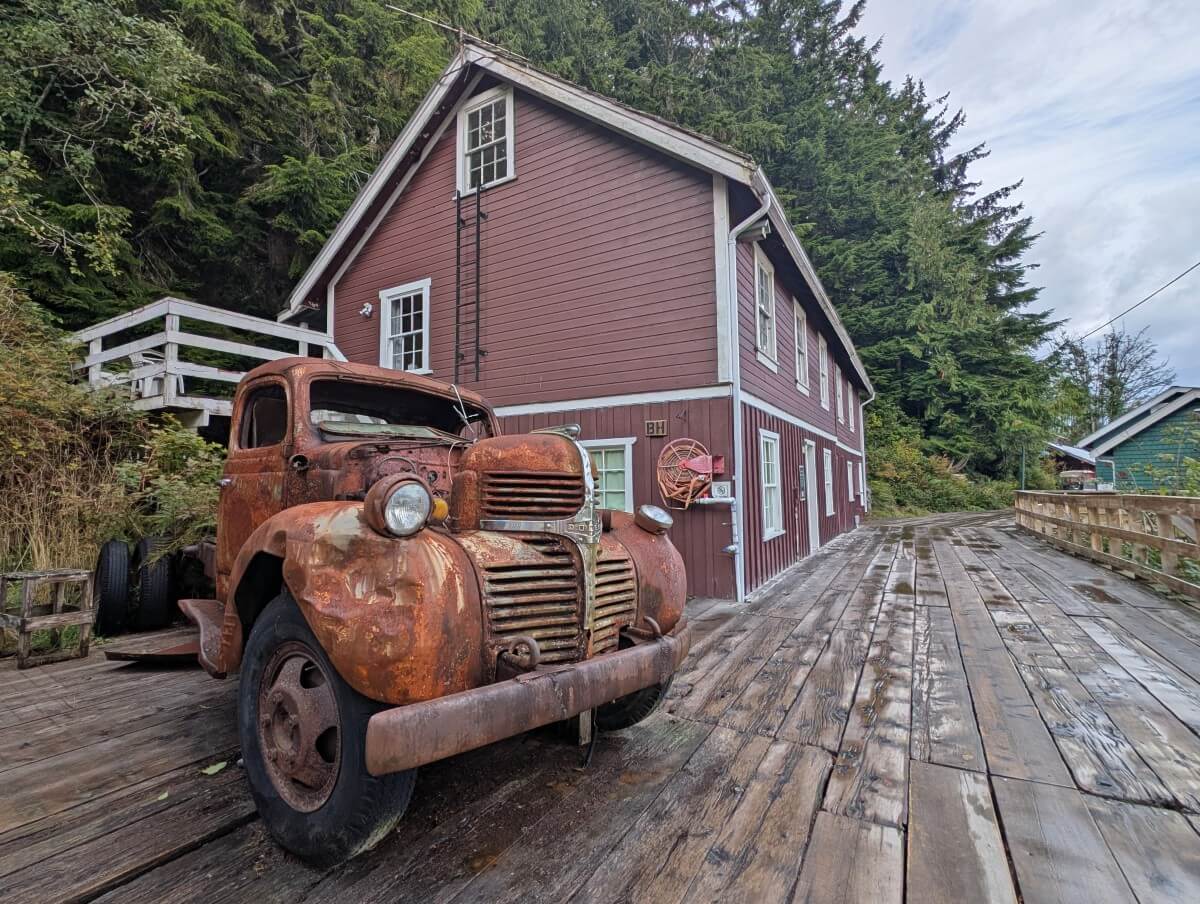
Where to stay
With the tour starting so early (usually 7am), it is easiest to stay in Telegraph Cove itself. I don’t usually get up that early so being able to walk to the office rather than drive was definitely preferable for me.
Telegraph Cove Resort has a range of cottages, hotel rooms and motel-style suites available, most with ocean and/or village views.
We stayed in the hotel building on the hill at the back of Telegraph Cove. The large rooms have everything you need for a night or two. You still get ocean views, even if there’s no balcony.
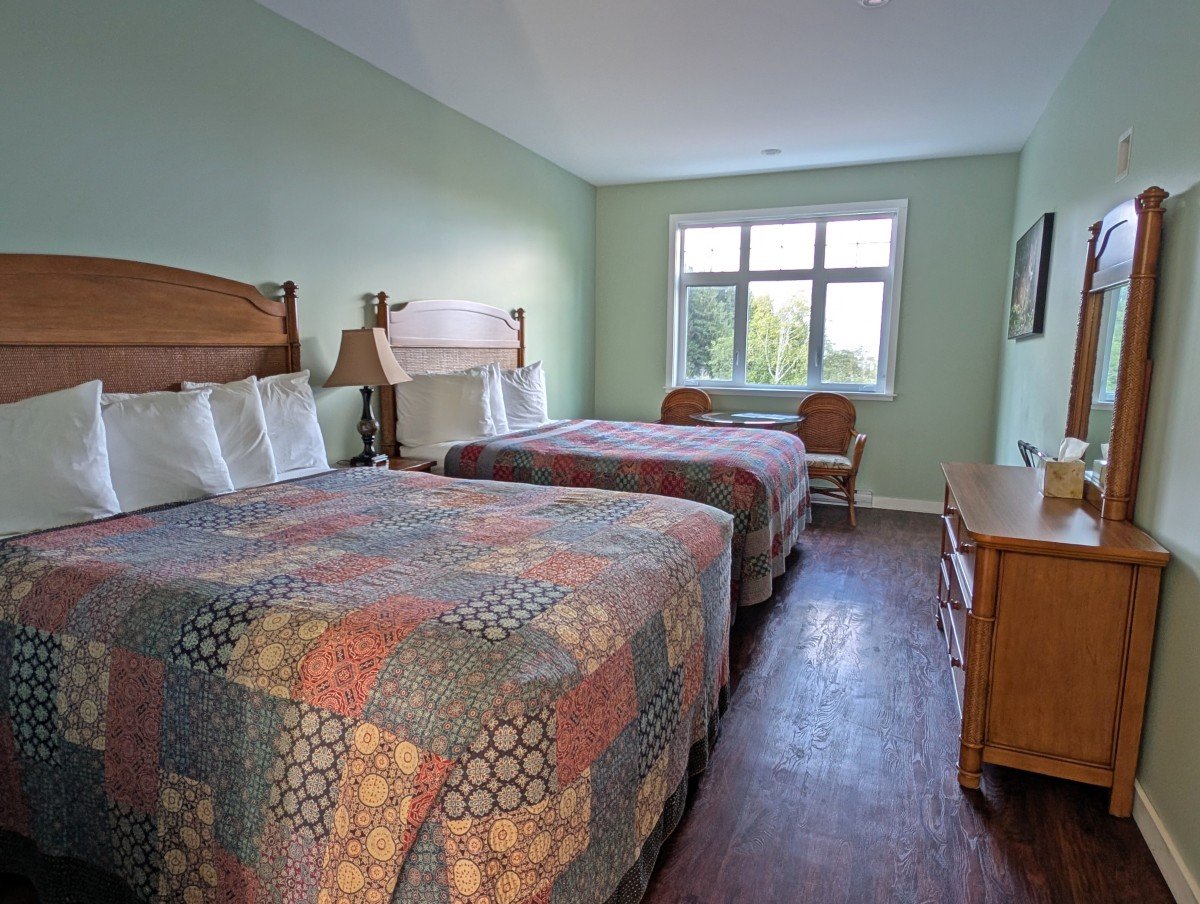
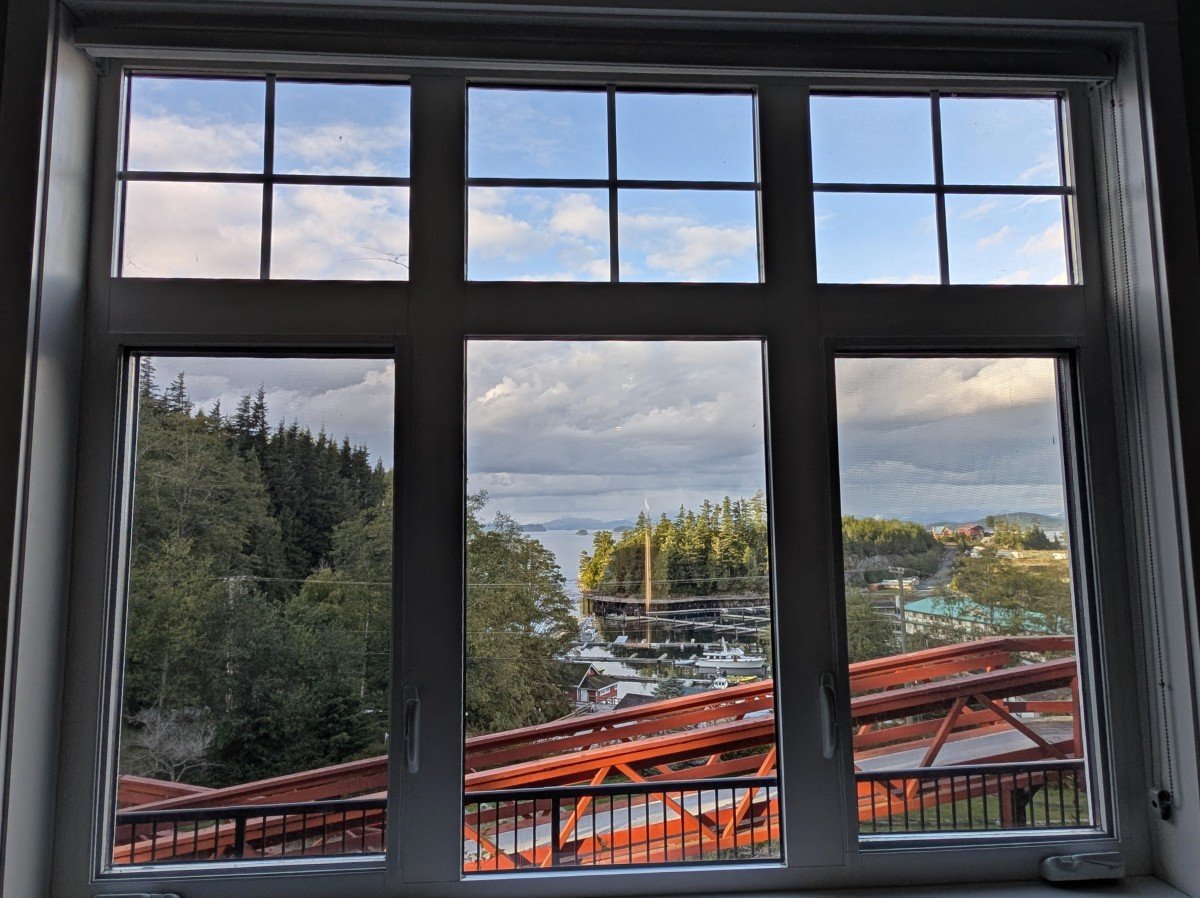
The recent fire has left food options in Telegraph Cove more limited, but in 2025 there was a small menu of hot food available from the General Store for lunch and dinner (burgers, soups, wraps, fish and chips).
Alternatively, plan to stay in the nearby town of Port McNeill. It’s 20 minutes away by car and has a bigger choice of hotels, motels and B&Bs.
The Humpback Inn is highly rated and is situated on Beach Drive, just across from the ocean. It’s also very close to the Devils’ Bath Brewery.
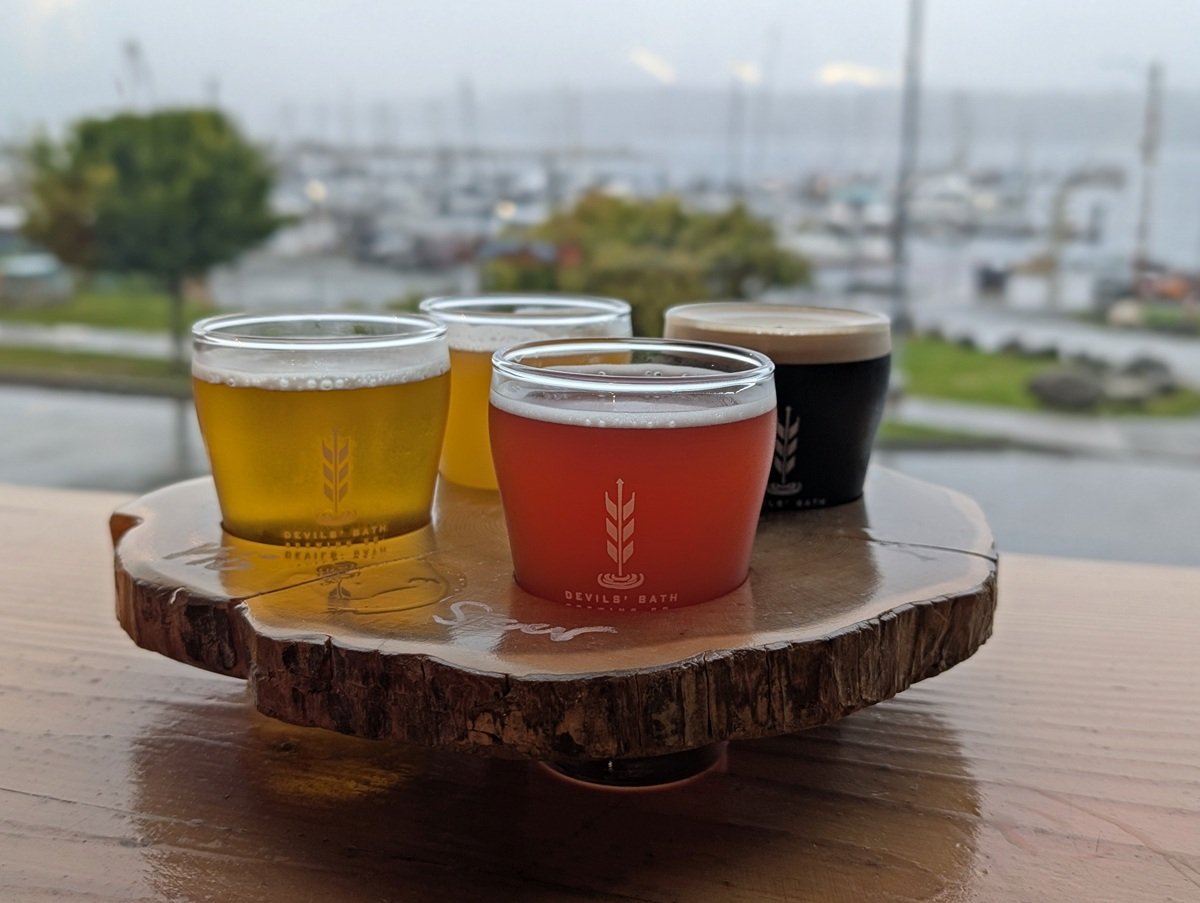
Other things to do in Telegraph Cove and North Vancouver Island
We love North Vancouver Island and have spent many weeks this region exploring over the years.
In Telegraph Cove, be sure to walk the boardwalk and read all of the information plaques that explain the stories of each heritage building.
The short Bauza Cove hiking trail is worthwhile to explore. Leaving from the campground, the 600m return path winds through beautiful old growth forest before reaching a gorgeous small beach.
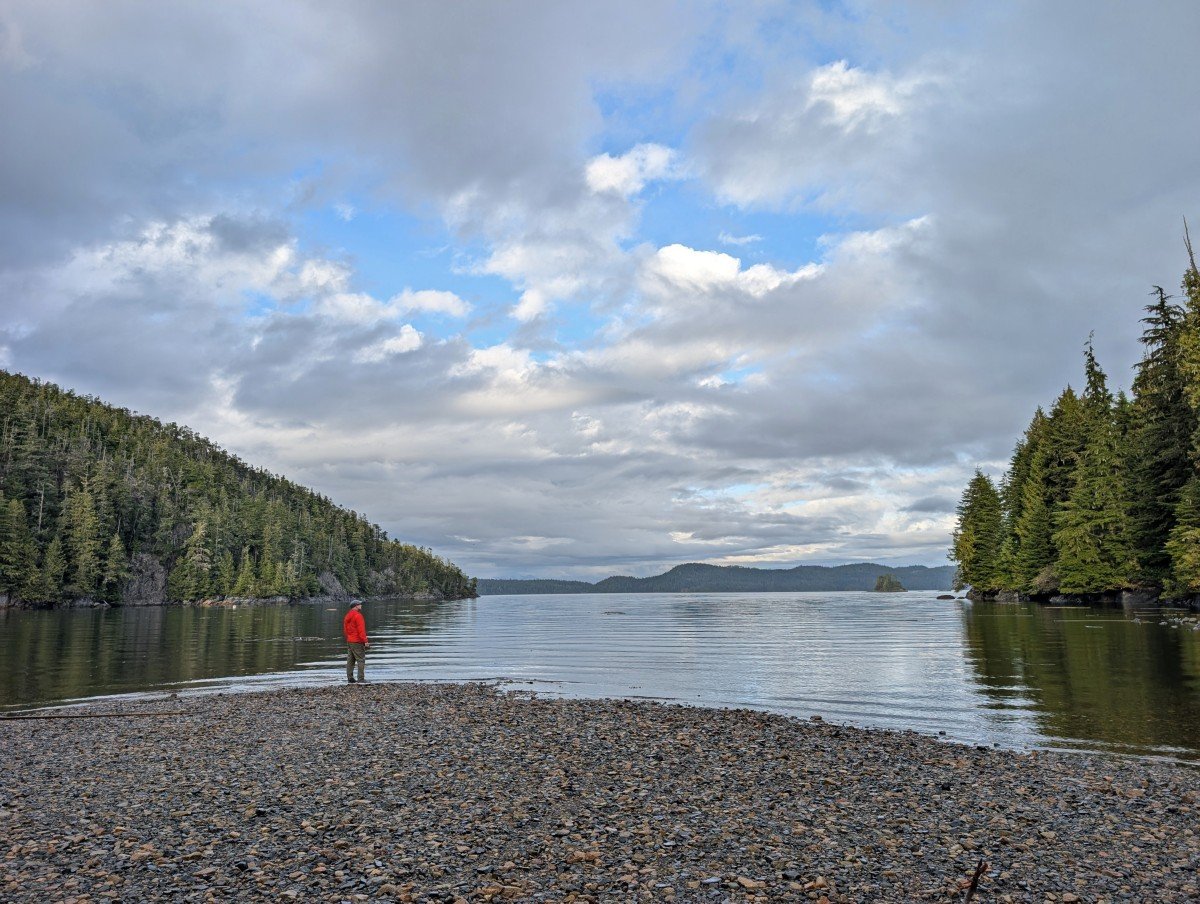
On the way to Telegraph Cove, I’d suggest visiting Elk Falls, Dalrymple Creek and/or Woss Heritage Park. All are fairly short stops, one hour or less.
If you have more time, consider the Ripple Rock Trail (8km return hike) to a viewpoint overlooking the site of the largest non-nuclear planned explosions in the world.
Port McNeill is a town with a beautiful waterfront and fantastic locally-owned brewery. It is also the jumping-off point for trips to Malcolm Island (Sointula) and Cormorant Island (Alert Bay).

Port Hardy is located at the end of Highway 19 – only unpaved industrial roads continue beyond. The remote and wild Cape Scott Provincial Park, home to stunning sandy beaches and old growth forest, is one of the most popular destinations.
On the way back to Campbell River, a stop at Little Huson Caves is a must. It is one of the most accessible cave systems on Vancouver Island.
More information about all of these activities and destinations in our Campbell River to Port Hardy road trip guide.
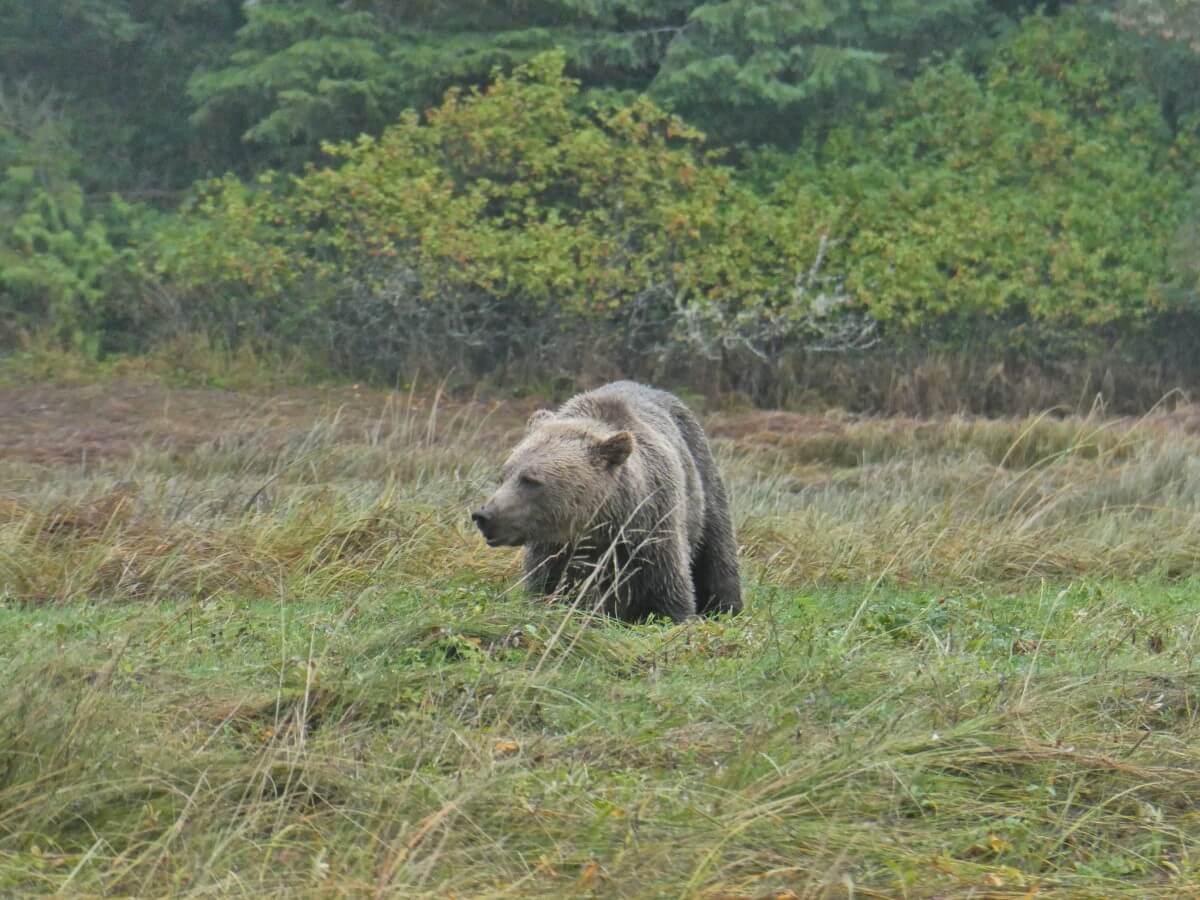
More Vancouver Island posts you may find helpful
Coastal Circle Route, BC: Best Places to Stop, Road Trip Itinerary + Map
North Coast Trail: Complete 2025 Backpacking Guide
Where to Find Big Trees on Vancouver Island
25+ Amazing Vancouver Island Waterfalls You Must Visit
San Josef Bay, Vancouver Island: Hiking and Camping Guide
22+ of the Best Campgrounds on Vancouver Island, BC
Nanaimo to Tofino Road Trip Guide: 15 Amazing Places to Stop

Planning a trip to Vancouver Island?

Our Vancouver Island Travel Guide features an interactive map with 150+ of the best things to see and do.
The itinerary builder tool makes it easy to create your perfect trip.
Download the app and use offline while travelling!


One half of the Canadian/British couple behind Off Track Travel, Gemma is happiest when hiking on the trail or planning the next big travel adventure. JR and Gemma are currently based in the beautiful Okanagan Valley, British Columbia, Canada. Consider buying us a coffee if you have find any of our guides helpful!

